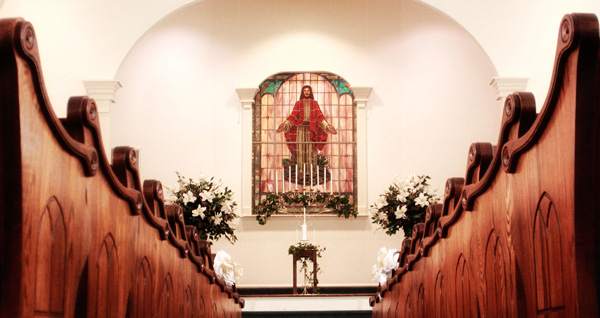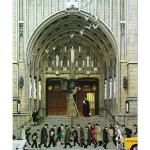 I’m a member of Alaska’s largest church. It’s a lot like every other megachurch. We meet in a cavernous, windowless room with stage lighting and two huge projection screens. We’re led by a rock band and a casually dressed pastor. The service lasts exactly 75 minutes. Our church draws a large crowd that attends sporadically. There’s a relatively small, highly committed core of members that keeps the machine going.
I’m a member of Alaska’s largest church. It’s a lot like every other megachurch. We meet in a cavernous, windowless room with stage lighting and two huge projection screens. We’re led by a rock band and a casually dressed pastor. The service lasts exactly 75 minutes. Our church draws a large crowd that attends sporadically. There’s a relatively small, highly committed core of members that keeps the machine going.
I like my church. But it’s in Anchorage, 26 miles from my house. So my wife and I occasionally worship at a small traditional church in our little town of Chugiak. (Let’s call it St. Mark’s)
We’ve been enjoying our Sundays at St. Mark’s. The richness and rigor of the liturgy is refreshing after years of seeker-sensitive services. It’s an eight-course meal, carefully measured out for us by church fathers – confession, forgiveness, praise, instruction, communion, giving, fellowship and benediction. It’s like a spiritual multivitamin in an easy-to-swallow, hour-long pill.
St. Mark’s has a lot going for it. The people are friendly, but not overly so. There is a healthy number of kids and young adults. The facility is well kept. The sermons are insightful. We love the depth of the hymns – and the people sing robustly (as opposed to most megachurches where very few people sing). It takes my wife back to the 100-member churches of her youth.
But last Sunday was different. Once a month, this little church does a contemporary service. Gina and I were surprised – unpleasantly so.
We arrived to find the pastor without his clerical robe. A projection screen had been lowered in front of the organ pipes. We sang praise choruses instead of hymns, led by a solo guitarist who had trouble keeping the beat. The congregation did not seem to know the songs, so they sang tentatively. On a positive note, the sermon was good as usual, and the pastor skillfully used PowerPoint slides to reinforce his message.
But on balance, the overall quality of the service was not up to par. Had this been our first Sunday at St. Mark’s it’s unlikely we would have returned.
So what went wrong? This little church was trying to be something it’s not.
St. Mark’s is a traditional church. And it’s very good at being a traditional church. But it’s a lousy contemporary church.
It’s an article of faith these days that contemporary worship is the way to go if you want your church to grow. Thousands of churches will be planted this year – and every one will offer contemporary worship. Hymns are out – love songs to Jesus are in.
Traditional churches have seen young believers flocking to megachurches, so naturally they want to get in on the growth. But this is foolish. Traditional churches lack the musical depth, computer controlled lighting and sound equipment that are needed to generate the “praise-gasm” that young believers associate with God. Rock music seems out of place in a brightly lit chapel with a communion table and stained glass.
People come to church to encounter God. A good worship service is transcendent; it helps people detach from this present world to connect with the divine. But when traditional churches try to be contemporary it usually comes across as forced, stilted or artificial. This dissonance jerks people back into the mundane world. Worshippers focus on the distraction instead of the Lord.
So here’s my advice to every church: be who you are. Do what you do well – and do it over and over. If you want to innovate, do so within the bounds of your culture.
Radio stations understand this princple. You won’t find the local pop music station playing the occasional Beethoven concerto. Nor will the country music station spin Lil’ Wayne’s latest rap record. Our local “Mix” radio station plays a variety of songs – but they’re all within the same genre – familiar pop/rock hits of the past 30 years.
If your church is big enough to offer two services, it might make sense to designate one a “traditional service” and the other a “contemporary service.” But if you offer just one service, stick with what you do best.
What has this got to do with men? Guys appreciate a quality worship service — but they are not very forgiving of anything hokey or half-baked. If guys want contemporary worship, they’ll go to a megachurch. Meanwhile, I firmly believe there’s still a market for traditional worship — even among the young — if it’s done in Spirit and in Truth.
In my next post, I’ll take you inside a 150-year-old mainline church that’s found a way to grow again – without abandoning its traditions. To learn more about this amazing congregation, click here.
 David Murrow is the author of the bestselling book, Why Men Hate Going to Church. David’s books have sold more than 175,000 copies in 12 languages. He speaks to groups around the world about Christianity’s persistent gender gap. He lives in Alaska with his wife of 30 years, professional silk artist Gina Murrow. Learn more about David at his Web site, www.churchformen.com, or join the conversation on his Facebook page, www.facebook.com/churchformen. Don’t forget to share this page by clicking on the links below, or scroll down and leave a comment (right below those annoying ads that pay for this blog).
David Murrow is the author of the bestselling book, Why Men Hate Going to Church. David’s books have sold more than 175,000 copies in 12 languages. He speaks to groups around the world about Christianity’s persistent gender gap. He lives in Alaska with his wife of 30 years, professional silk artist Gina Murrow. Learn more about David at his Web site, www.churchformen.com, or join the conversation on his Facebook page, www.facebook.com/churchformen. Don’t forget to share this page by clicking on the links below, or scroll down and leave a comment (right below those annoying ads that pay for this blog).
















